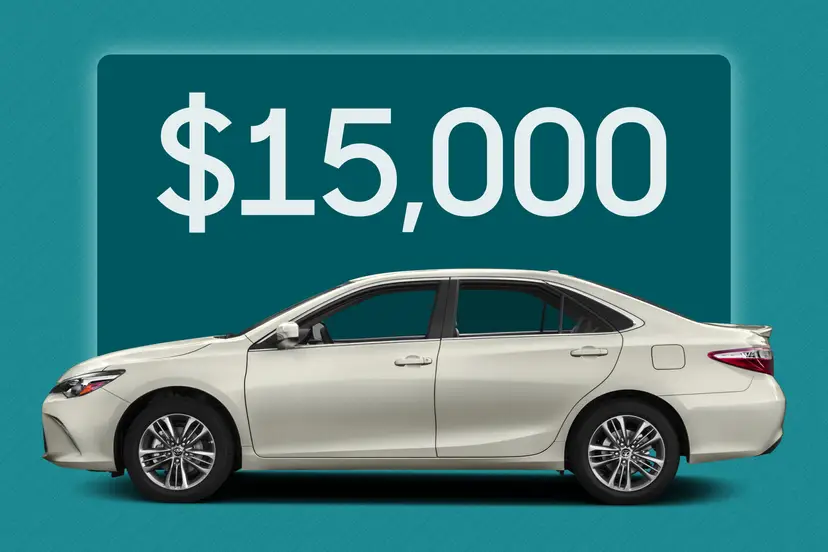
Competence can be a curse. Both the truly great and the truly awful stick out in one’s memory. But the competent — neither good nor bad — can fail to make an impression.
The 2015 Toyota Camry Hybrid competently and unobtrusively pounds out the miles as a commuter, but it doesn’t stir one’s passion to drive and its mileage doesn’t top the class.
Toyota updated the Camry Hybrid for 2015 with changes to the exterior, interior and feature set. You can compare it with the 2014 model here.
The model we tested came with Toyota’s Entune Premium Audio system with navigation and a collection of apps that let you check things such as weather and stock prices, among other functions, plus a three-month trial subscription of SiriusXM radio. We also had optional remote start ($499), wireless mobile phone charging ($75) and a power moonroof ($915).
Several automakers sell a hybrid midsize sedan, so the Camry Hybrid is up against a crowded and competitive field. Compare the 2015 Toyota Camry Hybrid with the 2015 Ford Fusion Hybrid, 2015 Honda Accord Hybrid and 2015 Kia Optima Hybrid here.
Exterior & Styling
The Toyota Camry Hybrid gets new headlights and taillights, but the biggest change is the new larger front grille. I’m not in love with the new grille, but I don’t have the same level of distaste that others do.
The Camry Hybrid looks fairly conservative from the side and rear, with a lot of angular surfaces. I think its profile view is its best.
In fact, overall I was a fan of how the Camry Hybrid looked, especially in our test model’s Blue Crush Metallic paint. I do, however, think the grille is an area where Toyota would be better served by trying not to be memorable.
How It Drives
Better mileage over conventional equivalents has long been the hybrid calling card, though to varying degrees. Here, the Camry Hybrid’s mileage looks good when compared with its conventional sibling, but it doesn’t wow in the broader hybrid market.
The Camry Hybrid is fuel economy is EPA-rated 40/38/40 mpg city/highway/combined, compared with a four-cylinder Camry’s rating of 25/35/28 mpg and a six-cylinder Camry’s rating of 21/31/25 mpg. Shoppers intent on buying a Camry who are most concerned with mileage are compelled to choose the hybrid and its 12-15 mpg combined bump.
In the broader market, against the Fusion Hybrid and Accord Hybrid, the Camry Hybrid trails in combined mpg fuel economy estimates by 2 mpg and 7 mpg, respectively. It fares better against the 2015 Hyundai Sonata Hybrid and 2015 Kia Optima Hybrid, where the Camry Hybrid’s combined mpg estimates are 2 mpg better. The Sonata has been redesigned for 2016, though, and EPA estimates show it just beating the Camry Hybrid in the EPA’s combined ratings. As of this writing, 2016 Sonata Hybrids haven’t hit dealer lots.
In our testing, several editors found 40 mpg easy to obtain, whether they used the mileage-enhancing Eco feature or not; the EPA estimates seem to hold true in the real world, in both optimal and sub-optimal weather.
Acceleration is acceptable, moving away from lights and making passes on the highway easily enough. It’s not as crisp and quick as a non-hybrid car, but this generation of the Camry Hybrid feels more like a “real” car than previous generations. The Camry Hybrid’s transmission has continuously variable gearing that can provide an odd, almost elastic response on the highway. There was a bit of that, but no worse than a lot of non-hybrid cars with continuously variable automatic transmissions. (The Toyota hybrid system doesn’t use that kind of belt-and-pulley design, but it does have continuously variable gear ratios.)
The Camry Hybrid can operate as a purely electric-motor vehicle in certain situations and then seamlessly kick in the 2.5-liter four cylinder engine when it’s needed. There’s an accompanying change in engine noise, but that’s it.
The Camry Hybrid is not designed to be a sports car. It’s not dramatic, and that’s OK — perhaps preferable in a commuter car. Life, jobs and commuting to work can be hard enough; the last thing we need is a car that gets in on the act and beats us up more. The fact that the Camry Hybrid gets you to work in an unflustered, undramatic manner is forgettable, but it’s powertrain is also commendable.
Braking is poor, however, even for a car aimed at commuters. The pedal feels very spongy, and stopping is hard to modulate. Hybrids use regenerative braking, in which the car’s inertia is used to generate electricity to charge the batteries, slowing the car. Particularly in early hybrids, there can be an odd, jerking sensation when braking. I could barely detect any such thing when braking in the Camry Hybrid; the overall braking feel is just too mushy and spongy.
The ride is good: Bumps and rough spots are soaked up pretty well; only enormous potholes send a judder up through the car. When pushed, the Camry Hybrid is predictable, tending to plow into turns and not snap around.
Interior
The hybrid Toyota Camry is a comfortable car with good room for its class. I’m about 6 feet 2 inches tall and I wasn’t cramped in the front seat — even in a version with the optional moonroof (a feature that diminishes headroom by about an inch). Backseat room was also fine for me with the driver’s seat set to where I’d positioned it. The seat is a little low to the floor, which results in raised knees, but headroom was roomy enough.
The only complaint I had was that I wished the telescoping steering wheel would extend slightly more, though I’ve noticed after sharing cars with our other reviewers (including tall ones) that I tend to want the steering wheel closer than others. It’s certainly not a deal-breaker for me.
However, the interior materials drew near-universal disdain from our reviewers. A number of surfaces are soft to the touch, but they don’t look great. This carried through to the rear seats, where the Camry Hybrid has a particularly uninspired design. This is an area where other models show better attention to detail, and it really hurts the Camry Hybrid in head-to-head comparisons.
Camry Hybrids are available in LE, SE and top-of-the-line XLE trim levels. We tested the SE version, so this is not a base model of the Camry Hybrid that we’re picking on. The Camry Hybrid edges toward the front of the class in terms of visibility. Like most cars today, the Camry’s front pillars slope back at a very shallow angle, and that design by its nature limits visibility. Fortunately, the pillars aren’t extremely thick and the angle is just steep enough, so seeing out the Camry Hybrid is basically fine.
Rear visibility is very good, partially because the trunk isn’t as high as those of many competitors. The backup camera is one of the better ones on the market, as it offers a very wide view of what’s behind you. It tends to distort a bit at the edges — as a wide-angle lens would do — but I’ll take that distortion if it means I have a more panoramic view.
I like to judge visibility by how confident I feel, either when I go for a gap in traffic on the highway or while maneuvering the Camry Hybrid in a tight parking garage after a hard day at work. The Camry Hybrid aced this test.
Lastly, the Camry Hybrid is a quiet car. I found very little road noise intruding into the cabin, and there was practically no wind noise, even when pushed to 70-plus mph on the highway. This, too, is welcome on any commute.
Ergonomics & Electronics
Toyota’s Entune Premium Audio system works well, as all the connected apps are displayed on the center infotainment system screen with large, easy-to-read, easy-to-touch buttons.
The steering wheel is crowded with buttons to the point that, at first glance, it appears a bit overwhelming. With more use, though, they became very familiar. They were also large enough that I could use them fairly easily while wearing gloves.
There are also large buttons flanking the screen to swap between apps, and that’s the source of my biggest beef with the system: If you want to swap to the navigation view, you have to first hit the “App” button and then select “Navigation” from the touch-screen. It’d be better if there were just a button that said “Nav,” rather than this two-step process.
Our test model also came with a wireless phone charging pad, a $75 option. Buyers should check if their phone is Qi-compatible (no Apple iPhones are as of this writing). If it is, a case that’s too thick can prevent charging.
Overall, Toyota deserves commendation for how well-laid-out the cabin is. It’s easy and intuitive to adjust everything from the headlights to the intermittent windshield wipers to the climate controls.
Cargo & Storage
The Camry Hybrid’s cabin has a lot of well-designed storage provisions, chief of which is a cavernous center console. For all the things that are federally mandated in cars these days, it’s the Camry Hybrid’s center console storage that most makes me think, “They should have to make all cars like this.”
The cupholders and bottleholders are also of a decent size, holding everything except my 32-ounce, wide-mouth Nalgene bottle (though few cars can do that).
The trunk is also large, but buyers should be aware that the rear seats do not fold in the same way conventional Camry seats do. Instead of a standard 60/40-split folding backseat, the hybrid makes do with a single folding segment. The cabin opening it creates when folded is roughly 40 percent of the seat’s width, but unfortunately it’s also elevated from the trunk floor and only about a foot tall. Sadly, this limitation is common among hybrid sedans.
Safety
The 2015 Toyota Camry Hybrid has been designated a Top Safety Pick Plus by the Insurance Institute for Highway Safety. This means it scored the institute’s highest rating of good (from possible scores of good, acceptable, marginal and poor) in its various dynamic tests and offers an optional forward collision prevention system that’s rated advanced (from a possible basic, advanced or superior).
In the class of affordable midsize sedans, the Camry is one of four rated a Top Safety Pick Plus. Even the lower-rated sedans are strong performers in this very competitive class.
All Camry Hybrids have a standard backup camera. A blind spot monitoring system with rear cross-traffic alert is optional on the highest, XLE trim. Likewise, as part of an option package XLE buyers can get a precollision system that can slow the car before a collision, as well as a lane departure warning system.
To browse a complete list of safety features, click here.
Value in Its Class
Prices for most of the midsize hybrids are close, with only the Accord Hybrid costing significantly more (and providing significantly better mileage).
If mileage is the sole basis for your decision, others turn in higher figures. But, here again, the Camry Hybrid is close to most of its competitors and enough higher than its conventional sibling to justify the hybrid’s existence.
By no means is it a perfect car, though. The brakes and general dynamics prevent any driving exuberance, and the Camry Hybrid’s interior appearance really lags the competition.
Where the Camry excels is in quietly getting you where you’re going without loudly announcing its presence. An attraction to that kind of quiet competence, more than a need for the nicest interior and absolute peak mileage, is what will likely draw buyers to the Camry Hybrid.
| Send Bill an email |
































.png)



